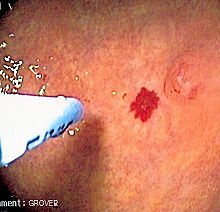Argon plasma coagulation
Since the beginning of the 1990s, argon plasma coagulation or APC has been the indicated medical endoscopic procedure for stopping bleeding from certain lesions (injuries) of the gastrointestinal tract and for removing tumors for which conventional surgery is not recommended becomes. It is used during an esophagogastroduodenoscopy or colonoscopy .
Establishment
After the method of sclerotherapy for blood vessels and bleeding surfaces with hot-wire instruments, argon plasma coagulation is a real advance. The method of argon plasma coagulation was initially used successfully in open operations, especially for hemostasis in organs. The process works without contact and without smoke formation. It is therefore ideal for working through an endoscope probe. The advancement of technology has made the instruments ever slimmer, so that today they can be used universally for purposes of hemostasis, even in larger areas, and operations through a probe. The procedure is particularly suitable for the heat-dependent coagulation of skin surfaces, the arrest of superficial bleeding and the necrotization of pathologically questionable tissue parts. The maximum easily controllable penetration depth is 3 to 4 mm.
Mode of action
A unipolar procedure is typically used, with the patient's body on one pole and the tip of the probe on the other. With a specifically generated electrical flashover (flame arc), the tissue surface is denatured by the action of heat .
With APC, the tip of the probe is represented by an ionized argon plasma beam . The probe is passed through an endoscope . The argon is ionized at the tip of the probe by a high voltage discharge (approx. 5 kV). The ionized gas jet serves as a conductor for a high-frequency electric current which, when the tissue is heated , leads to coagulation of the lesion. The electricity is generated by a generator (see picture) with the desired strength.
Argon is a noble gas and is used for several reasons.
- Argon is widely available in the atmosphere and is therefore inexpensive.
- Argon is biologically harmless and non-toxic and is excreted again via the breathing cycle.
- It does not make any connection with any element. The tip of the probe remains unaffected (is not attacked).
- Argon can be ionized well .
practice
The probe is guided near the lesion to be treated until a sparkover (electric arc) occurs. The contact is made exclusively via the plasma jet. Since no physical contact is made with the lesion, the procedure is safe and well suited for treating bleeding in parts of the gastrointestinal tract with thin walls. The penetration depth is usually only a few millimeters. The scab formation is low, so that a later tearing of the wound is largely avoided. In addition, there is no adherence to the probe or any unwanted adherence of the probe to the treated tissue. For physical reasons, the plasma jet automatically turns away from coagulated (high-resistance) areas towards bleeding or not yet sufficiently coagulated (low-resistance) tissue areas in the application area. In this way, an automatically limited, uniform coagulation is achieved not only in depth, but also over the surface. Rising blood or tissue fluid is blown out of the treatment area by the argon gas jet so that the surfaces and vessels that are actually to be reached are always exposed.
Areas of application
APC is used to treat the following conditions:
- Angiodysplasia , anywhere in the GI tract
- antral vascular ectasia or watermelon stomach
- Radiation proctitis
- Esophageal cancer
- Closure of varices in combination with band ligation
- Colon polyps after polypectomy
When used in the intestine, it must first be safely freed of colon gases (methane) so that undesired effects cannot occur due to deflagration.
See also
Individual evidence
- ↑ Kay Matthews MD: Argon Beam Coagulation, New Directions in Surgery . In: AORN Journal . No. 56 , November 1992, doi : 10.1016 / S0001-2092 (07) 68755-9 , PMID 23725530 (English).
- ↑ a b K.E. Last, D. Storek, G. Farin: Endoscopic argon plasma coagulation (APC) first clinical experiences in flexible endoscopy . In: Endosc. Surg. Allied Technol. 1st edition. No. 2 , February 1994, ISSN 0942-6027 , p. 42-46 , PMID 8081915 (English).
- ↑ G. Farin, KE Grund: Technology of argon plasma coagulation with particular regard to endoscopic applications . In: Endosc. Surg. Allied Technol. 1st edition. No. 2 , February 1994, ISSN 0942-6027 , p. 71-77 , PMID 8081921 (English).
- ↑ ASGE Technology Committee, Jeffrey Tokar, et al .: Electrosurgical generator . In: GIE - Gastrointestinal Endoscopy . 2nd Edition. No. 78 , August 2013, p. 197–208 , doi : 10.1016 / j.gie.2013.04.164 (English).
- ↑ B. Hug, R. Haag: High frequency surgery - devices and methods. In: Medical technology, Springer Reference Technology. 2015, accessed September 1, 2019 .
- ↑ K.-Q. Shi: Secondary prophylaxis of variceal bleeding for cirrhotic patients: a multiple treatments meta-analysis . In: European Journal of Clinical Investigation . 8th edition. No. 43 , August 2013, p. 844-854 , doi : 10.1111 / eci.12115 , PMID 23725530 (English).
- ↑ SD Ladas, G. Karamanolis, E. Ben-Soussan: Colonic gas explosion during therapeutic colonoscopy with electrocautery . In: World Journal of Gastroenterology . 40th edition. No. 13 , 2007, p. 5295-8 , PMID 17879396 , PMC 4171316 (free full text) - (English).

